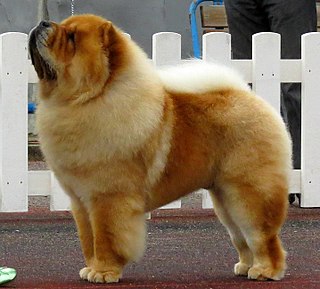
The Chow Chow is a spitz-type of dog breed originally from Northern China. The Chow Chow is a sturdily built dog, square in profile, with a broad skull and small, triangular, erect ears with rounded tips. The breed is known for a very dense double coat that is either smooth or rough. The fur is particularly thick in the neck area, giving it a distinctive ruff or mane appearance. The coat may be shaded/self-red, black, blue, cinnamon/fawn, or cream.

The Great Dane is a German breed of large mastiff-sighthound, which descends from hunting dogs of the Middle Ages used to hunt bears, wild boar, and deer. They were also used as guardian dogs of German nobility. It is one of the two largest dog breeds in the world, along with the Irish Wolfhound.

The Boxer is a medium to large, short-haired dog breed of mastiff-type, developed in Germany. The coat is smooth and tight-fitting; colors are fawn or brindled, with or without white markings. Boxers are brachycephalic, have a square muzzle, mandibular prognathism, very strong jaws, and a powerful bite ideal for hanging on to large prey. The Boxer was bred from the Old English Bulldog and the now extinct Bullenbeisser, which became extinct by crossbreeding rather than by a decadence of the breed. The Boxer is a member of both The Kennel Club and American Kennel Club (AKC) Working Group.

The Poodle, called the Pudel in German and the Caniche in French, is a breed of water dog. The breed is divided into four varieties based on size, the Standard Poodle, Medium Poodle, Miniature Poodle and Toy Poodle, although the Medium Poodle is not universally recognised. They have a distinctive thick, curly coat that comes in many colors and patterns, with only solid colors recognized by breed registries. Poodles are active and intelligent, and are particularly able to learn from humans. Poodles tend to live 10–18 years, with smaller varieties tending to live longer than larger ones.
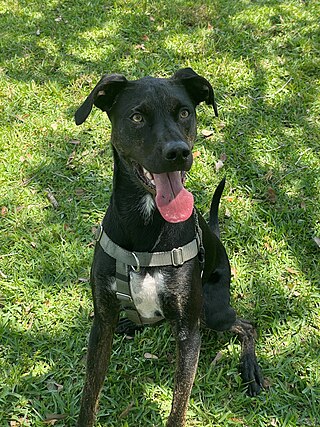
A mongrel, mutt, or mixed-breed dog is a dog that does not belong to one officially recognized breed, including those that result from intentional breeding. Although the term mixed-breed dog is sometimes preferred, many mongrels have no known purebred ancestors.
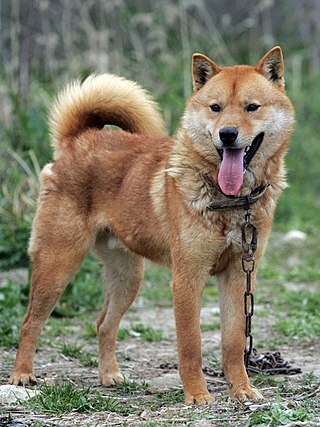
The Jindo dog is an indigenous dog native to the island of Jindo in South Korea. It is also known as Jindo-gyeon and formerly known as the Chindo dog.

The Belgian Shepherd, also known as the Belgian Sheepdog or the Chien de Berger Belge, is a Belgian breed of herding dog of medium size. It is bred in four distinct varieties based on coat type and colour: the long-haired black Groenendael; the rough-haired fawn Laekenois; the short-haired fawn Malinois, and the long-haired fawn Tervuren. The American Kennel Club considers the four varieties to be separate breeds.

The French Bulldog is a French breed of companion dog or toy dog. It appeared in Paris in the mid-nineteenth century, apparently the result of cross-breeding of Toy Bulldogs imported from England and local Parisian ratters. It is commonly kept as a pet and is among the most frequently registered dogs in a number of countries including Australia, the United Kingdom, and the United States. The breed is susceptible to various health problems as a consequence of being bred for a distinctive appearance, sporting a brachycephalic face and skin wrinkles.

The Bouvier des Flandres is a herding dog breed originating in Flanders, Belgium. They were originally used for general farm work including cattle droving, sheep herding, and cart pulling, and nowadays as guard dogs and police dogs, as well as being kept as pets.

The Fila Brasileiro is a Brazilian breed of large working dog of mastiff type.

The Cane Corso is an Italian breed of mastiff. It is usually kept as a companion dog or guard dog; it may also be used to protect livestock. In the past it was used for hunting large game, and also to herd cattle.

The Eurasier, or Eurasian, is a spitz type breed of dog that originated in Germany through cross-breeding between popular European and Asian Spitz. It is widely known as a wonderful companion that maintains its own personality, has a dignified reserve with strangers, has a strong bond to its family, and is relatively easy to train.

The Dutch Shepherd is a herding dog of Dutch origin. They were used by shepherds and farmers who needed a versatile dog that made few demands and was able to adapt to a harsh and meager existence.

The Taiwan Dog is a breed of small or medium dog indigenous to Taiwan. These dogs are also known as the Formosan Mountain Dog. They are well-adapted to the uneven and thickly forested terrain of Taiwan, having become a semi-wild breed prior to the arrival of several colonial reigns and foreign powers. Notwithstanding these adaptations, Formosans retained the potential to be trained and are now used as hunting dogs, guard dogs, stunt dogs, rescue dogs, or simply as companions. Formosans are classified into one medium type and two small types.
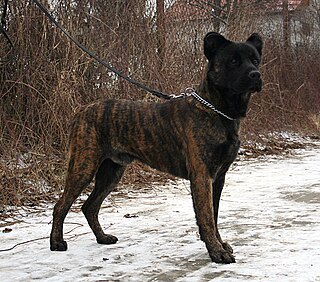
The Saint Miguel Cattle Dog is a dog breed of mastiff type originating on São Miguel Island in the Azores, an island chain which is one of the autonomous regions of Portugal. The breed was originally used as a herding dog for working with cattle.

The Basset Artésien Normand is a short legged hound type dog developed in France. The word basset refers to short-legged hounds.
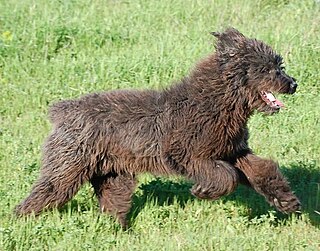
The Sardinian Shepherd Dog or Fonni's Dog is an ancient landrace breed of Sardinian dog used as a herding, catching, and livestock guardian dog.
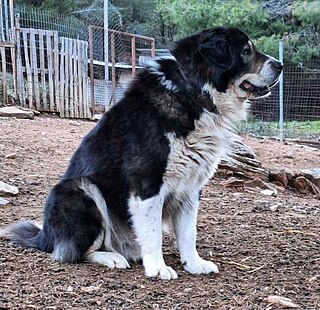
The Greek Shepherd or Greek Sheepdog is a breed of livestock guardian dog from Greece. Thought to be ancient in origin, the Greek Shepherd is very closely related to livestock guardian dog breeds from neighbouring countries; it is believed that some dogs are simultaneously claimed to be other breeds as they migrate annually across national borders with the flocks they protect in search seasonal pastures.
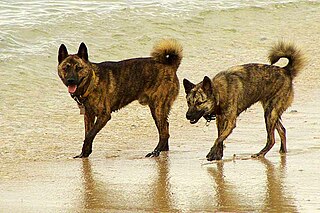
The Ryukyu dog is an endangered, medium-sized, Japanese breed of dog indigenous to Okinawa and Ishigaki Island. There were as few as 400 Ryukyu as of 2015. Unlike dogs such as the Kai Ken, the Ryukyu dog is not protected by the Nihon Ken Hozonkai, but instead is protected by the Ryukyu Inu Hozonkai.

Pampas Deerhound is a Brazilian breed of hunting dog; it is also found in Argentina and Uruguay. It is common in Brazil, where it was first recognized by a national kennel club. The dogs were used to track, capture, and hunt deer, and thus earned the name Pampas Deerhound. It is still a widely preferred hunting companion to track other animals, such as wild boars.






















